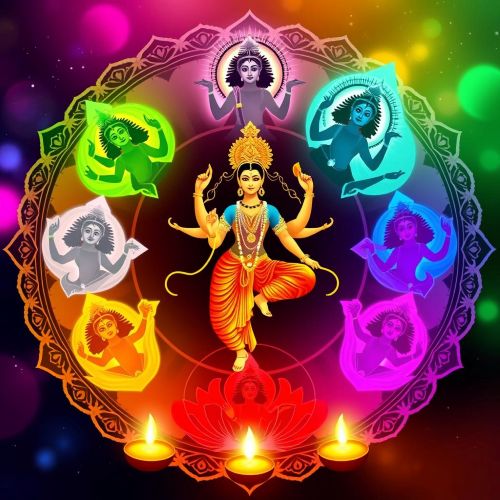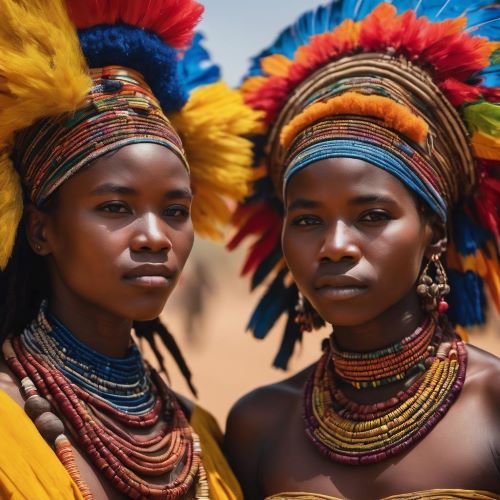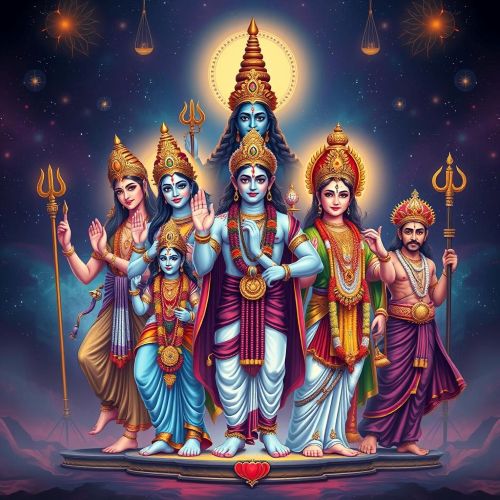The Navratri Goddess Guide: Nine Days, Nine Colors, and Nine Forms
Navratri, meaning “nine nights,” is one of the most vibrant Hindu festivals dedicated to the divine feminine. It honors the goddess in her nine manifestations, collectively called Navadurga, who represent courage, purity, wisdom, and prosperity. Each day of Navratri is devoted to one avatar of the Navratri goddess, celebrated with specific rituals, prayers, and symbolic colors that guide the devotion of worshippers. These colors change daily, adding beauty and deeper meaning to the festival while reflecting the attributes of the goddess being worshipped.
1. Shailaputri – The Daughter of the Mountain (Color: Yellow)
The first day of Navratri begins with the worship of Shailaputri, the daughter of the Himalayas and a form of Goddess Parvati. Representing purity and stability, she rides a bull named Nandi and carries a trident and lotus in her hands. Yellow, the color of joy and positivity, is associated with this day and reflects new beginnings, making it a perfect start to the Navratri goddess celebrations. Devotees pray to Shailaputri for strength and balance as they embark on the nine-day spiritual journey.
2. Brahmacharini – The Goddess of Devotion (Color: Green)
The second day honors Brahmacharini, the goddess of penance and discipline who embodies perseverance and self-control. Depicted walking barefoot with a rosary in one hand and a water pot in the other, she radiates peace and spiritual power. Green, the color of harmony and growth, is associated with her day, symbolizing new life and serenity. Devotees worship Brahmacharini to receive blessings of wisdom, determination, and liberation from suffering.
3. Chandraghanta – The Goddess of Courage (Color: Grey)
On the third day, devotees celebrate Chandraghanta, the goddess who wears a crescent moon on her forehead. Known for her bravery and fierce protection, she rides a lion and carries multiple weapons. Her presence dispels negativity and instills courage. Grey is the color for this day, reflecting calmness, balance, and the ability to stay composed in the face of adversity. Worshipping this Navratri goddess is believed to bring peace, fearlessness, and strength into the lives of devotees.
4. Kushmanda – The Cosmic Creator (Color: Orange)
The fourth day of Navratri is devoted to Kushmanda, the radiant goddess credited with creating the universe with her divine smile. She is depicted with eight or ten arms holding symbolic objects, radiating warmth and energy like the sun. Orange, the color of enthusiasm and creativity, is worn on this day to represent her vibrant energy. As a Navratri goddess, Kushmanda blesses her devotees with health, vitality, and prosperity.
5. Skandamata – The Mother of Kartikeya (Color: White)
On the fifth day, Skandamata, the nurturing mother of Lord Kartikeya, is worshipped. She rides a lion and holds her child in her lap, representing both motherly affection and protective strength. White, the color of purity, peace, and serenity, is associated with this day. Devotees believe that worshipping this form of the Navratri goddess brings blessings of wisdom, compassion, and salvation. Skandamata embodies the selfless love of a mother who protects and nurtures her children.
6. Katyayani – The Warrior Goddess (Color: Red)
The sixth day is dedicated to Katyayani, one of the fiercest forms of Durga, born to sage Katyayana to destroy evil forces. She rides a lion and is armed with a sword and lotus, symbolizing power and righteousness. Red is the color for this day, representing strength, passion, and energy. Young women often pray to Katyayani for marital bliss and happiness. This Navratri goddess is celebrated as a warrior who ensures justice and the triumph of good over evil.
7. Kalaratri – The Dark Night of Protection (Color: Royal Blue)
On the seventh day, devotees honor Kalaratri, the most ferocious form of Durga who destroys demons and evil. With her dark complexion, untamed hair, and blazing aura, she looks fearsome but remains benevolent toward her devotees, offering protection from danger and fears. Royal Blue, symbolizing divine energy and power, is the color of this day. Worshipping Kalaratri, the Navratri goddess of destruction, assures protection, auspiciousness, and relief from negativity.
8. Mahagauri – The Goddess of Peace (Color: Pink)
The eighth day is dedicated to Mahagauri, the radiant goddess who symbolizes purity, forgiveness, and serenity. Clad in white and riding a bull, she reflects calmness and inner strength. Pink is the color for this day, representing hope, compassion, and universal love. Devotees pray to this Navratri goddess to be freed from sins and granted peace, fulfillment of desires, and clarity of thought. Mahagauri is revered as a compassionate mother who nurtures her children with unconditional love.
9. Siddhidatri – The Goddess of Supernatural Powers (Color: Purple)
The final day of Navratri is dedicated to Siddhidatri, who grants siddhis or supernatural powers to her devotees. Seated on a lotus, she carries a mace, discus, conch, and lotus, symbolizing completeness. Purple, the color of spirituality and ambition, represents her day and highlights her role as the goddess of enlightenment. Siddhidatri signifies the culmination of Navratri goddess worship, blessing devotees with wisdom, success, and the merging of material and spiritual worlds.
Conclusion
The nine avatars of Durga worshipped during Navratri reflect a powerful spiritual journey, beginning with purity and ending in wisdom and perfection. Each day’s color adds symbolism, guiding devotees to align themselves with divine energy. These forms of the Navratri goddess embody love, courage, compassion, and strength, inspiring worshippers to overcome difficulties and embrace virtue. Navratri is not just a festival but a celebration of feminine power, resilience, and the eternal victory of good over evil. As families come together for prayers, Garba dances, and festive rituals, the worship of Navadurga keeps cultural traditions alive while uniting communities across the world.
No posts were found.









